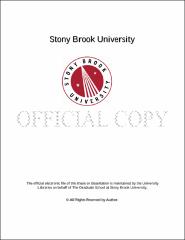| dc.identifier.uri | http://hdl.handle.net/11401/77396 | |
| dc.description.sponsorship | This work is sponsored by the Stony Brook University Graduate School in compliance with the requirements for completion of degree. | en_US |
| dc.format | Monograph | |
| dc.format.medium | Electronic Resource | en_US |
| dc.language.iso | en_US | |
| dc.publisher | The Graduate School, Stony Brook University: Stony Brook, NY. | |
| dc.type | Dissertation | |
| dcterms.abstract | The evolution of host use--the preference and ability to utilize plant species--has long occupied a central role in theories on how and why insects are among the most diverse lineages on earth. Yet the genomic basis of host-range evolution remains poorly understood, partly because most studies concern species-level comparisons, where reproductive isolation is already complete, obscuring the evolutionary changes that may have initiated divergence. To advance our understanding of host-range evolution at the instraspecific, genomic level, I generate and investigate genomic data for populations of the aphid Uroleucon ambrosiae (Ua) that diverge in host use traits--eastern North American populations specialize on giant ragweed, while those in the arid southwest exploit a broad range of host plant genera. Three sets of analyses were used to clarify the host-use history of U. ambrosiae and characterize genomic divergence among its generalist and specialist populations. First, multi-locus sequence data and host records are used to resolve the phylogeny of the genus, and establish that Ua is part of an adaptive radiation of species feeding on Asteraceae tribes that began 0.5-2 million years ago. Second, the population-level transcriptome is assembled and annotated, and compared to the pea aphid genome. These results indicate that lineage-specific gene expansion has likely been an important factor as Uroleucon species diversified on host plants in the family Asteraceae. Finally, expressed sequences are compared among multiple generalist and specialist Ua populations. Genes that possibly contribute to functional divergence of host use traits are identified using a combination of outlier analyses based on pair-wise allele frequency divergence (D), the fixation index (FST), and the ratio of non-synonymous to synonymous substitutions (Ka/Ks). These results identify several candidate genes for divergent host use, including constituents of salivary secretions as well as several genes involved in digestive metabolic processes. | |
| dcterms.available | 2017-09-20T16:52:37Z | |
| dcterms.contributor | Futuyma, Douglas J. | en_US |
| dcterms.contributor | Eanes, Walter | en_US |
| dcterms.contributor | Rest, Joshua | en_US |
| dcterms.contributor | Funk, Daniel. | en_US |
| dcterms.creator | Gill, Aman | |
| dcterms.dateAccepted | 2017-09-20T16:52:37Z | |
| dcterms.dateSubmitted | 2017-09-20T16:52:37Z | |
| dcterms.description | Department of Ecology and Evolution. | en_US |
| dcterms.extent | 132 pg. | en_US |
| dcterms.format | Application/PDF | en_US |
| dcterms.format | Monograph | |
| dcterms.identifier | http://hdl.handle.net/11401/77396 | |
| dcterms.issued | 2015-08-01 | |
| dcterms.language | en_US | |
| dcterms.provenance | Made available in DSpace on 2017-09-20T16:52:37Z (GMT). No. of bitstreams: 1
Gill_grad.sunysb_0771E_12021.pdf: 3904809 bytes, checksum: 010de9ebb649e4cd21de8ce1fae872c3 (MD5)
Previous issue date: 2014 | en |
| dcterms.publisher | The Graduate School, Stony Brook University: Stony Brook, NY. | |
| dcterms.subject | Genetics | |
| dcterms.subject | aphid, ecological divergence, genome scan, host use, transcriptome | |
| dcterms.title | The making of a generalist: mining the transcriptome to characterize host-use evolution in the aphid Uroleucon ambrosiae. | |
| dcterms.type | Dissertation | |

